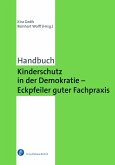Workforce Profiles in Early Childhood Education and Care (eBook, PDF)
Trends and Challenges in 33 European Countries


Alle Infos zum eBook verschenken

Workforce Profiles in Early Childhood Education and Care (eBook, PDF)
Trends and Challenges in 33 European Countries
- Format: PDF
- Merkliste
- Auf die Merkliste
- Bewerten Bewerten
- Teilen
- Produkt teilen
- Produkterinnerung
- Produkterinnerung

Hier können Sie sich einloggen

Bitte loggen Sie sich zunächst in Ihr Kundenkonto ein oder registrieren Sie sich bei bücher.de, um das eBook-Abo tolino select nutzen zu können.
Dieses Buch bietet ein detailliertes Bild des frühpädagogischen Personals in Europa. Welche Anforderungen werden im Hinblick auf die Qualifikation gestellt? Wie sehen Wege in den Beruf aus? Wodurch sind die jeweiligen Arbeitskontexte geprägt? Welche politischen Initiativen werden ergriffen? Welche Herausforderungen gibt es? Diese Fragen wurden im Rahmen eines dreijährigen Forschungsprojekts in 33 Ländern untersucht. Das Buch fasst zentrale Ergebnisse zusammen und präsentiert länderübergreifende Vergleiche ausgewählter Aspekte im Kontext der unterschiedlich strukturierten Systeme der frühkindlichen Bildung und Kindertagesbetreuung.…mehr
- Geräte: PC
- ohne Kopierschutz
- eBook Hilfe
- Größe: 1.81MB
- FamilySharing(5)
![Fachkräftemangel und De-Professionalisierung in der Sozialen Arbeit (eBook, PDF) Fachkräftemangel und De-Professionalisierung in der Sozialen Arbeit (eBook, PDF)]() Fachkräftemangel und De-Professionalisierung in der Sozialen Arbeit (eBook, PDF)0,00 €
Fachkräftemangel und De-Professionalisierung in der Sozialen Arbeit (eBook, PDF)0,00 €![Prekäre Professionalität (eBook, PDF) Prekäre Professionalität (eBook, PDF)]() Elke AlsagoPrekäre Professionalität (eBook, PDF)0,00 €
Elke AlsagoPrekäre Professionalität (eBook, PDF)0,00 €![Wandel der Arbeitsgesellschaft (eBook, PDF) Wandel der Arbeitsgesellschaft (eBook, PDF)]() Wandel der Arbeitsgesellschaft (eBook, PDF)23,99 €
Wandel der Arbeitsgesellschaft (eBook, PDF)23,99 €![Kinder- und Jugendhilfe: Das Lehrbuch über die strukturellen Arbeitsbedingungen (eBook, PDF) Kinder- und Jugendhilfe: Das Lehrbuch über die strukturellen Arbeitsbedingungen (eBook, PDF)]() Markus EmanuelKinder- und Jugendhilfe: Das Lehrbuch über die strukturellen Arbeitsbedingungen (eBook, PDF)18,99 €
Markus EmanuelKinder- und Jugendhilfe: Das Lehrbuch über die strukturellen Arbeitsbedingungen (eBook, PDF)18,99 €![Professionals in early childhood education and care systems (eBook, PDF) Professionals in early childhood education and care systems (eBook, PDF)]() Pamela OberhuemerProfessionals in early childhood education and care systems (eBook, PDF)39,99 €
Pamela OberhuemerProfessionals in early childhood education and care systems (eBook, PDF)39,99 €![Kinderschutz in der Demokratie - Eckpfeiler guter Fachpraxis (eBook, PDF) Kinderschutz in der Demokratie - Eckpfeiler guter Fachpraxis (eBook, PDF)]() Kinderschutz in der Demokratie - Eckpfeiler guter Fachpraxis (eBook, PDF)55,99 €
Kinderschutz in der Demokratie - Eckpfeiler guter Fachpraxis (eBook, PDF)55,99 €![Kindheit zwischen Recht und Schutz: Wissen und Praktiken von Fachkräften im Kinderschutz (eBook, PDF) Kindheit zwischen Recht und Schutz: Wissen und Praktiken von Fachkräften im Kinderschutz (eBook, PDF)]() Rita Braches-ChyrekKindheit zwischen Recht und Schutz: Wissen und Praktiken von Fachkräften im Kinderschutz (eBook, PDF)15,99 €
Rita Braches-ChyrekKindheit zwischen Recht und Schutz: Wissen und Praktiken von Fachkräften im Kinderschutz (eBook, PDF)15,99 €-
-
-
Dieser Download kann aus rechtlichen Gründen nur mit Rechnungsadresse in A, B, BG, CY, CZ, D, DK, EW, E, FIN, F, GR, H, IRL, I, LT, L, LR, M, NL, PL, P, R, S, SLO, SK ausgeliefert werden.
- Produktdetails
- Verlag: Verlag Barbara Budrich
- Seitenzahl: 157
- Erscheinungstermin: 11. November 2024
- Englisch
- ISBN-13: 9783847432050
- Artikelnr.: 72089692
- Verlag: Verlag Barbara Budrich
- Seitenzahl: 157
- Erscheinungstermin: 11. November 2024
- Englisch
- ISBN-13: 9783847432050
- Artikelnr.: 72089692
- Herstellerkennzeichnung Die Herstellerinformationen sind derzeit nicht verfügbar.







